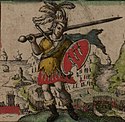Aescwine z Esseksu
 Wizerunek Aescwina z Esseksu na mapie kartografa Johna Speeda z 1611 | |
 | |
| król Essexu | |
| Okres | |
|---|---|
| Następca | |
| Dane biograficzne | |
| Data śmierci | |
| Dzieci | |
Aescwine z Esseksu (znany również jako Erkenwine, Æscwine lub Erchenwine) (ur. ?, zm. 587) – półlegendarny osadnik ze Starej Saksonii, który w 527 założył Królestwo Essex (terytorium pokrywające się ze współczesnym hrabstwem Essex w Anglii), stając się jego pierwszym królem.
Niewiele jest informacji o jego pochodzeniu i dokonaniach. Po raz pierwszy jego imię pojawia się w genealogii rodu królewskiego Essex, sporządzonego w IX wieku w Wesseksie. Jest tam napisane, że pochodził z rodu, którego założycielem był Saxnot – legendarny przywódca Anglosasów.
Panował w nowym królestwie aż do śmierci w 587, kiedy to na tronie zastąpił go syn – Sledda.
Bibliografia
- Barbara Yorke: "The Kingdom of the East Saxon". 1985, s. 1-36.
Media użyte na tej stronie
Æscwine of Essex
Attributed arms of the Kingdom of Essex (the "East Saxons") in the Anglo-Saxon w:Heptarchy: Gules, three seaxes barwise in pale argent blades uppermost pommelled and hilted or. In 1932 adopted as the arms of Essex County Council. Text from https://london.wikia.org/wiki/Coat_of_Arms_of_Middlesex_County_Council :
- Coats of arms were invented in the Middle Ages for the Kingdoms of the Anglo-Saxon Heptarchy. That assigned to the Kingdom of the Middle and East Saxons depicted three "seaxes" or short notched swords on a red background. The seaxe was a weapon carried by Anglo-Saxon warriors, and the term "Saxon" may be derived from the word. These arms became associated with the two counties that approximated to the kingdom: Middlesex and Essex. County authorities, militia and volunteer regiments associated with both counties used the attributed arms. In 1910 it was noted that the county councils of Essex and Middlesex and the Sheriff's Office of the County of London were all using the same arms. Middlesex County Council decided to apply for a formal grant of arms from the College of Arms, with the addition of an heraldic "difference" to the attributed arms. Colonel Otley Parry, a Justice of the Peace for Middlesex and author of a book on military badges, was asked to devise an addition to the shield. The chosen addition was a "Saxon Crown", derived from the portrait of King Athelstan on a silver penny of his reign, stated to be the earliest form of crown associated with any English sovereign. The grant of arms was made by letters patent dated 7 November 1910. The undifferenced arms of the Kingdom were eventually granted to Essex County Council in 1932
Further reading:
- "Armorial bearings of Middlesex", The Times. London. 7 November 1910.
- The Book of Public Arms, A.C. Fox-Davies, 2nd edition, London, 1915
- Civic Heraldry of England and Wales, W.C. Scott-Giles, 2nd edition, London, 1953
- C W Scott-Giles, Royal and Kindred Emblems, Civic Heraldry of England and Wales, 2nd edition, London, 1953, p.11

